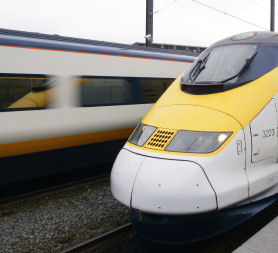Minister pledges cash to cut highspeed rail link noise
 Cathy Newman
Presenter
Cathy Newman
Presenter
Exclusive: The Transport Secretary battles to head off a ministerial revolt over the new high speed rail link, spending £215m on noise reduction measures along the route.

However, according to a confidential Government report, seen by Channel 4 News, nearly 5,000 homes will still be blighted by increased noise from the proposed London to Birmingham route.
The document, by consultants Booz and Co and Temple, reveals that 4,700 households will be hit by higher noise levels. A total of 150 properties will be so badly affected by noise that they will have to have double-glazing fitted at the government’s expense. Ten will be rendered uninhabitable.
But the report adds that if the Government failed to take steps to reduce decibel levels – for example by erecting wooden barriers, constructing tunnels and building trees – more than 25,000 homes would be blighted by noise.
Ministers have already warned that more than 400 homes would have to be destroyed to make way for the High Speed Two line, which will see trains travelling at 250mph. The plans have caused a public and political backlash, with several ministers threatening to quit in protest.
The Transport Secretary, Philip Hammond, told Channel 4 News he planned to spend £215m to address concerns by reducing noise levels. He proposes erecting wooden barriers, constructing tunnels and building trees.
“About £200million pounds worth of investment in so-called mitigation measures along the line from London to Birmingham.” Transport Secretary Philip Hammond
He said: “We’re going to be building acoustic fences, we’re going to be building earth mounds along the side of the railway, contouring the landscape to try to minimise the noise impacts on surrounding communities – planting trees both to help with noise and to provide visual screening of the noise barriers and the railway itself.
“About £200million pounds worth of investment in so-called mitigation measures along the line from London to Birmingham.”
He added that although he wouldn’t want high speed trains hurtling through his garden, he’d be happy to live a quarter of a mile from the line.
Richard Greer, an acoustic consultant at Arup – the main engineers on the project – said a 3m high wooden barrier would reduce train noise by 16 decibels.
“What we find time and time again is that when people experience high speed rail it’s not as loud or as noisy as they think it might be. There has been a lot of research over many years which shows that people are less annoyed by railway noise than they are by road traffic noise,” he added.
“Any expenditure of taxpayers money on this project before consultation is an act of pre-determination we will seek to challenge legally.” StopHS2 protester Lizzy Williams
Protesters are however dismayed that the government’s committing hundreds of millions of pounds of taxpayers’ money to the project before a public consultation, which opens next week. Ministers hope to prove that the economic benefits of the project will dwarf the £17bn cost of the London to Birmingham line.
Lizzy Williams, the chair of the StopHS2 pressure group who has walked the entire length of the route, said: “The public consultation hasn’t been carried out. The public haven’t decided whether they want this yet or not. Any expenditure of taxpayers money on this project before consultation is an act of pre-determination we will seek to challenge legally.”
I took a sound meter out to compare noise from super-fast trains with traffic. Sound from a train en route for Paris on the existing high speed rail line peaked at 92.5 decibels, albeit for a matter of seconds; noise from the M20 clocked up 87.7 decibels – but the noise was constant; and standing in a field of sheep, the meter barely went above 50db. Only a robin broke the silence.
-
Latest news
-
As India goes to the polls in the world’s largest election – what do British-Indians think?6m

-
Tees Valley: Meet the candidates in one of the biggest contests coming up in May’s local elections4m

-
Keir Starmer says public sector reform will be a struggle7m

-
Nicola Sturgeon’s husband Peter Murrell charged with embezzlement of funds from SNP1m

-
Ukraine might finally get $60billion in American weapons and assistance to defend against Russia3m

-




